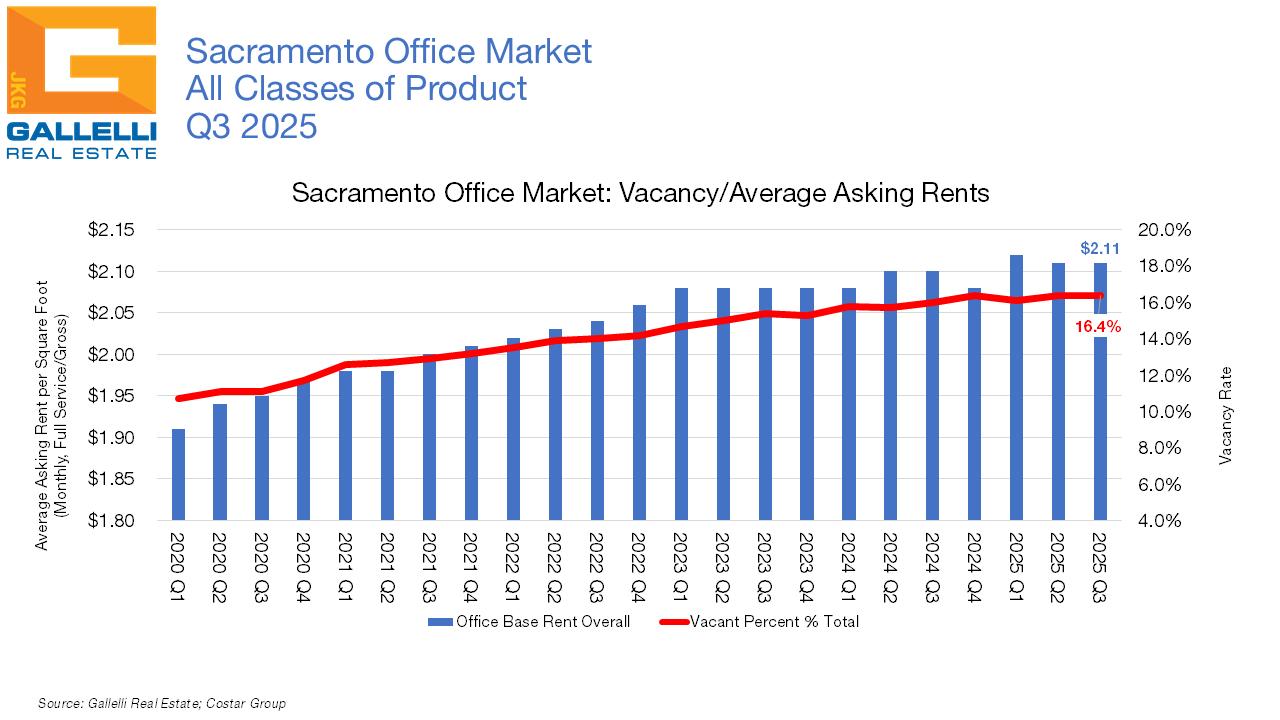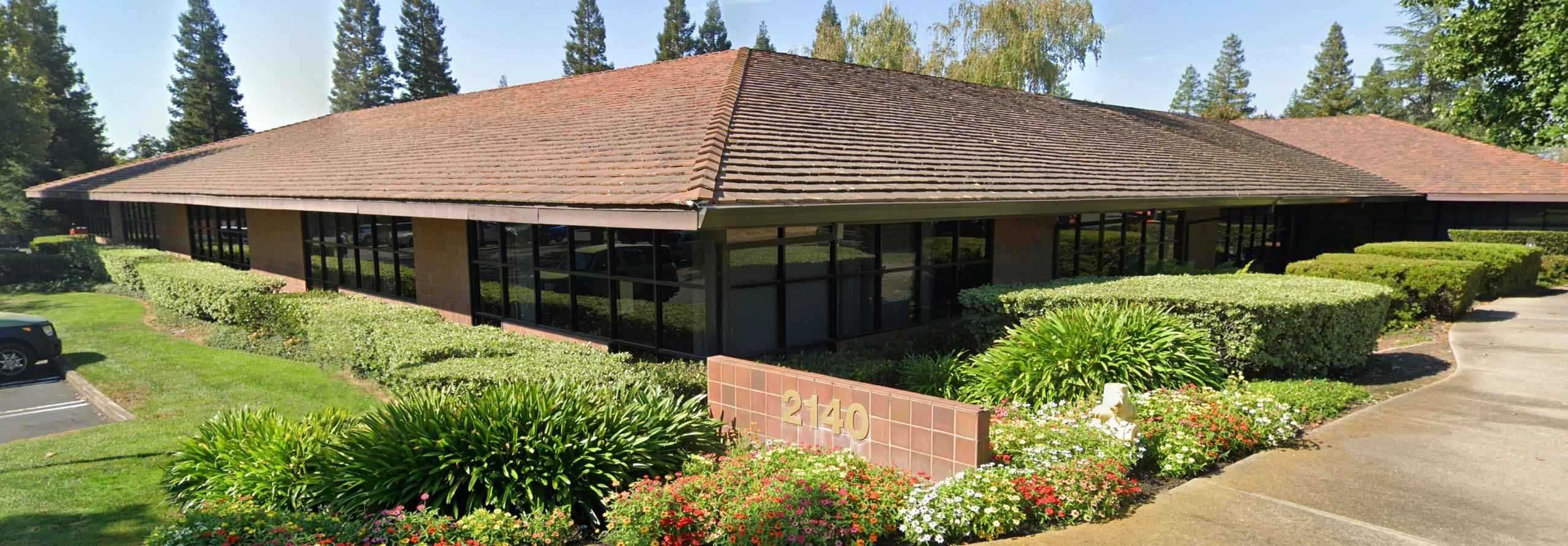

Q3 25 market overview

Asking Rate (NNN)
OFFICE POSTS STABLE, IF FLAT QUARTER, DESPITE HEADWINDS
Office vacancy in the Sacramento region stood at 16.4% as of the end of Q3 2025, reflecting little change from where it stood three months earlier. The market recorded negligible negative net absorption to the tune of -19,000 square feet (SF) in Q3 in what could best be described as a relatively flat quarter in terms of deal activity. Occupancy growth remained positive in seven of the region’s 12 distinct submarkets, but none saw significant gains or declines in terms of negative net absorption with no single trade area recording substantial movement in vacancy in either direction.
The market has recorded a vacancy rate of 16.4% in three of the past four quarters, reflecting stabilizing conditions after the challenges of the past few years that saw the pandemic trigger substantial givebacks of space as larger corporate users rethought space usage against the rising, and now declining, trend of remote and hybrid work. While that trend has been ebbing steadily for the past couple of years, local challenges have been prolonged by the long-planned consolidation of the State of California from leased office space into their new Downtown campus that began last year. Since 2024, the State has returned over 1.5 million square feet (MSF) of space to market even while our brokers were reporting gradually strengthening demand from the private sector.
Yet, Q3’s relatively flat performance reflects both slower deal activity and smaller deal size. The average lease transaction we are now tracking in the market is less than 5,000 SF. This has been the trend since the pandemic,

with local smaller professional businesses and medical users accounting for the bulk of deal flow with larger footprint players largely on the sidelines.
The good news is that both our brokers and competing players in the marketplace report that touring activity was on the upswing heading into Q4 2025 with hopes that the final quarter of the year may see the market return to growth territory.
Initial economic uncertainty regarding tariff impacts appears to be fading, with many companies that had paused moves earlier in the year returning to dealmaking. Consumer spending has continued to hold up far better than most early economist predictions, though many warn that the full impact of many tariffs has yet to hit the market. Meanwhile, unemployment remains near 50-year lows, but employment growth has been slowing substantially in recent months. September interest rate cuts from the Federal Reserve may help to change that, but the economic picture heading into the final months of 2025 remains *To
provide the most accurate snapshot of market conditions, we revise our historical data in cases where new information is uncovered after the fact.
Sacramento’s Shrinking Office Deal Size


cloudy. While US stock indices are all at or near historic highs, much of those gains in 2025 have been driven by companies at the forefront of artificial intelligence (AI) creation—with AI increasingly being cited as a driving force for layoffs and flattening employment growth. That trend is only likely to increase heading into 2026.
SUBMARKET REVIEW
Across the Sacramento region’s 12 distinct office submarkets, only five recorded negative net absorption in Q3 2025 and only two recorded space givebacks more than 50,000 SF. The Highway 50 submarket closed Q3 with vacancy up from the 23.1% rate posted most of the past year to 23.7% thanks to -74,000 SF of negative net absorption. Though this trade area was home to one of the largest deals of the quarter; Maximus’ renewal on 79,000 SF of space at Prospect Park, a spate of smaller givebacks pushed Highway 50 into the red, despite the encouraging approval of a $1 billion development plan for a 40-acre project along Trade Center Drive near Sunrise Boulevard that will create a true downtown area along with the addition of a sports arena, retail space and additional mixed-use projects/
The Folsom submarket also posted negative net absorption to the tune of -51,000 SF, though it was also home to one of the quarter’s largest new deals, Advanced Micro Devices took down 28,000 SF at 1180 Iron Point Road. Vacancy in the Folsom submarket now stands at 9.9%, up from 9.7% one year ago. Despite Q3’s uptick, it remains among the three trade areas in the Sacramento region with the lowest levels of vacancy.
The Midtown/East Sacramento trade area posted the strongest level of growth in Q3; 50,000 SF of positive net absorption. Nearly all of this is attributable to new tenants at the region’s new science and technology incubator, Aggie Square. This project, backed by the University of
California at Davis and Wexford Science & Technology, is looking to create the region’s first biotech hub and will, upon full completion, add over 1.0 MSF of office, medical office, and life science space. The delivery of 200 Aggie Square (314,000 SF) and 300 Aggie Square (255,000 SF) effectively emptied the region’s office development pipeline with 569,000 SF of space coming online this quarter.
El Dorado Hills posted 36,000 SF of positive net absorption, primarily from a mix of users taking occupancy at projects like the mixed-use El Dorado Hills Town Center. Vacancy fell from 18.7% to 16.3% this quarter and we have heard that a few deals in the works should keep this momentum in place for Q4.
The largest new deal of the quarter came from the California State Auditor who took 49,000 SF of space at 100 Waterfront Place in West Sacramento. Meanwhile, other larger transactions in the past three months have included Quest Diagnostics’ renewal on 44,000 SF at 3714 Northgate Boulevard in the Natomas submarket and the Department of Justice’s renewal on 29,000 SF at 2950 Del Paso Road (also in Natomas).
The current average asking rent for office space in the Sacramento region is $2.11 per square foot (PSF), on a monthly full-service basis. This metric is up a modest 0.5% year-over-year, despite recent challenges. Downtown remains the region’s priciest market, with an average asking rate of $2.86 PSF (though this metric has fallen -3.7% over the past year).
The Midtown/East Sacramento submarket follows with an average asking rent of $2.39 PSF, which has been buoyed by the rents at Aggie Square, which is leasing at rates ranging from $2.90 to $3.50 PSF.
990 Reserve Drive, Roseville


INVESTMENT UPDATE
Office investment activity since 2020 has been challenged. In the wake of weakening fundamentals, and then higher capital costs, office deals in recent years have been dominated by owner-user deals while investors have largely stayed on the sidelines waiting for opportunistic plays. With most US markets showing signs of stabilization, if not, the early innings of recovery, buyers have slowly ramped up activity. Through Q3 2025, we are aware of 69 closed office sales throughout the region, of which 19 were investment deals (the remainder were user sales). This compares with 49 total deals for the same period last year, of which 19 were investor plays. The largest deal we know of is the sale of the 308,000 MSF vacant former Hewlett Packard Campus in Roseville for $13.6 million, or $44 PSF. While there have been a handful of value-add or distress plays this year, most activity has centered around medical or smaller professional office properties. While we see the September interest rate cut by the Federal Reserve as a positive development for real estate, we don’t anticipate deal flow to pick up just yet. The good news is that Fed Chair Powell has already broadcast their intention to drop rates at least two more times before the end of the year based on current economic conditions. This should be a factor in increased activity heading into 2026 though we anticipate distress sales to continue to be forefront for investors while lower interest rates are also likely to boost owner purchases. One recent trend we think will get a considerable boost from cheaper capital is that of owners converting leased space in multitenant buildings to condo use for users that would like to own their space.
ARTIFICIAL
INTELLIGENCE LOOMS
LARGER AHEAD
Earlier in this report, we briefly touched on AI as being a factor starting to impact the labor market and its potential impact on the greater economy is clearly becoming a much more significant concern. In terms of commercial real estate, other than its’ already huge demand in spiking demand for data center space, there may be no other asset type that may be as directly impacted as the office market.
We suspect that even in a best-case economic scenario, the rising tide of AI adoption in the workplace will begin to emerge as a major structural challenge for the office market—at least in the intermediate term.
Some predictions have been stark, including from inside the industry itself. Dario Amodei, CEO of AI firm Anthropic, said in a May 2025 interview he thinks that nearly half of all white-collar jobs in tech, finance, law, and consulting could be replaced or eliminated by AI within five years. Detractors point out that such claims have only driven the sky-high valuations of AIfocused firms that have driven U.S. stock indices to record levels.
It is far too soon to tell what AI will ultimately mean to the office market. The optimistic take is that ultimately AI will free us from “grunt work.” That it will do some tasks that will free up employees to concentrate on different aspects of a job. For example, eliminating 20% to 30% of tasks in a position like data entry or repetitive functions so that a professional can focus on the 70% to 80% of tasks that might get a complementary benefit from the AI (AI-influenced sales management strategies, for example).
2140 Professional Road, Roseville, CA 95661

The pessimistic outlook is that if you look at the tasks that workers in whitecollar work can do and what we think that AI is already capable of, that this interlap impacts about 35% of the tasks that we see in the existing labor market. It remains to be seen which set of expectations the emerging AI reality will align with, much less the timetable with which it will become an even greater disruptor.
AI is already having an impact on the employment market. In early October, outplacement firm Challenger, Gray & Christmas released a report that detailed more than 17,000 job cuts that have been directly attributable to artificial intelligence so far this year with 7,000 AI-driven job cuts in September alone. Job cuts attributed to AI are expected to pick up substantially with greater AI adoption, but for now adoption remains low.
A recent report from Goldman Sachs estimated that as of July 2025, 13.4% of American firms with more than 250 employees had adopted some AI usage, compared to rates ranging from 7.5% to 10.0% for all other size of company. However, this report also noted that rates of AI adoption had doubled in the previous 12 months and were anticipated to increase at a 100% rate or more in the year to come.
According to the Goldman report, disruption so far has been focused on in a few key fields. Employment growth in marketing consulting, graphic design, office administration, and telephone call centers has fallen below trend thanks to reduced labor demand due to AI-related efficiency gains. The same report cited younger tech workers as being disproportionately affected so far, as those industries are the first adopters. Unemployment among 20- to 30-year-olds in tech-exposed occupations has risen by almost 3 percentage points since the start of 2025.
Meanwhile, Haver Analytics predicts that the roles most threatened by AI in the near-term future will be financial specialists, customer service representatives, software and web designers, accountants and auditors, computer support specialists, business operations specialists, paralegals, marketing specialists, HR specialists, management analysts, financial analysts, telemarketers, editors/ proofreaders and tax consultants.
There is a long history of new technologies stoking fear of displacement. The reality has been that new technologies tend to create demand for workers in new occupations that eventually outpace the jobs they eliminated. For example, according to U.S. Labor Department data, 60% of the US workforce are in occupations that did not exist as recently as 1950. Historically, upheaval from
technological innovations have tended to be temporary. But the question about AI is whether it is fundamentally different and could result in persistently elevated structural unemployment.
We do not have the answers to those larger questions. But the initial impacts of AI on office space usage are already playing out. The first is that increased demand from AI-producing firms has spiked in select U.S. tech-dominated markets. It has helped to fuel a revival narrative in the Bay Area (including San Francisco’s challenged office market), as well as an uptick in leasing in techhubs like Seattle and Boston.
But the second set of impacts we suspect will play out will be greater labor efficiencies from larger corporate users that, in general, have been twice as likely to invest in AI tools than smaller businesses. Here is where we see a lot of similarities between the remote/hybrid work trend and AI impacts in that, once again, it appears that large players will be those most likely to cut jobs (and therefore more likely to reduce demand for office space). We do not rule out staffing cutbacks from medium to smaller size firms that invest AI, but keep in mind that these organizations will already have little to no fat to cut. In fact, they might be the firms that could potentially see some of the strongest gains in productivity from these technologies. Office tenancy in the Sacramento region remains dominated by state and local government, as well as smaller professional firms and medical users. Exposure to where we anticipate the greatest disruption is limited with Sacramento likely to fare better than most should some of the darker case scenarios around AI impact on office-using labor begin to play out.
Ironically, one trend we expect to be accelerated due to the rising corporate adoption of AI tools is the return to in-office work. Over the past couple of years employers have increasingly been reducing remote and hybrid work offerings and demanding greater in-office attendance from employees. While unemployment remains below the 5.0%-mark, job creation has flatlined in recent months. Should layoffs climb and unemployment begin to spike, whether due to AI or not, we think it is likely that many workers will voluntarily return to in-office work schedules. As one HR recruiter told us, “If suddenly these new AI tools mean that a company can cut a department’s staff by 25%, it’s only natural that you are going to see employees respond to that threat. The common fear would be that if you are out of the office, you might be the first one to be out of a job.”

OFFICE MARKET STATISTICS: Criteria based on: 10,000 SF and above, does not include owner occupied, Existing, Under Construction, Proposed, Final Planning
Grove/South Sacramento

GALLELLI BROKER TEAMS







rosborne@gallellire.com





Land/Investments ebenoit@gallellire.com






